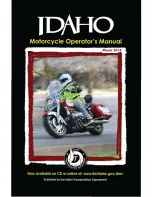
37
How to Ride the Motorcycle
To Start the Engine
Check that the engine stop switch is
in the run position.
Ensure the transmission is in neutral.
Pull the clutch lever fully into the
handlebar.
Turn the ignition switch on.
NOTE
• When the ignition is switched
on, the speedometer and
tachometer
needles
will
quickly sweep from zero to
maximum and then return to
zero. The instrument warning
lights will illuminate and will
then go off (except those
which normally remain on
until the engine starts – see
‘warning lights’ on page
22
).
It is not necessary to wait for
the needles to return to zero
before starting the engine.
•
The motorcycle is equipped
with starter lockout switches.
The switches prevent the
electric
starter
from
operating
when
the
transmission is not in neutral
with the sidestand down.
Warning
Never start the engine or run the
engine in a confined area. Exhaust
fumes are poisonous and can
cause loss of consciousness and
death within a short period of time.
Always operate your motorcycle in
the open-air or in an area with
adequate ventilation.
Caution
Do not operate the starter
continuously for more than 5
seconds as the starter motor will
overheat and the battery will
become discharged. Wait 15
seconds between each operation
of the starter to allow for cooling
and recovery of battery power.
Do not let the engine idle for long
periods as this may lead to
overheating which will cause
damage to the engine.
Caution
The low oil pressure warning light
should go out shortly after the
engine starts.
If the low oil pressure warning light
stays on after starting the engine,
stop the engine immediately and
investigate the cause. Running the
engine with low oil pressure will
cause severe engine damage.
Classic Cycles Technical Resources
















































